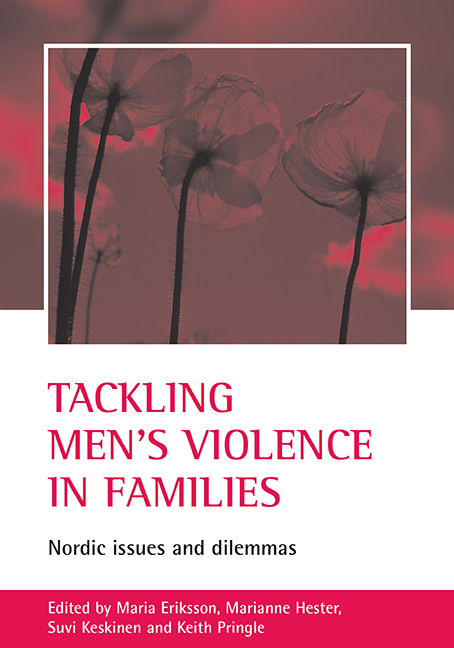Book contents
- Frontmatter
- Contents
- List of tables and figures
- Acknowledgements
- Notes on contributors
- one Introduction: Nordic issues and dilemmas
- two Children, abuse and parental contact in Denmark
- three Commitments and contradictions: linking violence, parenthood and professionalism
- four “Talking feels like you wouldn’t love Dad anymore”: children’s emotions, close relations and domestic violence
- five Bypassing the relationship between fatherhood and violence in Finnish policy and research
- six Marching on the spot? Dealing with violence against women in Norway
- seven Children’s peace? The possibility of protecting children by means of criminal law and family law
- eight A visible or invisible child? Professionals’ approaches to children whose father is violent towards their mother
- nine “Take my father away from home”: children growing up in the proximity of violence
- ten Neglected issues in Swedish child protection policy and practice: age, ethnicity and gender
- eleven Tackling men’s violence in families: lessons for the UK
- References
- Index
five - Bypassing the relationship between fatherhood and violence in Finnish policy and research
Published online by Cambridge University Press: 20 January 2022
- Frontmatter
- Contents
- List of tables and figures
- Acknowledgements
- Notes on contributors
- one Introduction: Nordic issues and dilemmas
- two Children, abuse and parental contact in Denmark
- three Commitments and contradictions: linking violence, parenthood and professionalism
- four “Talking feels like you wouldn’t love Dad anymore”: children’s emotions, close relations and domestic violence
- five Bypassing the relationship between fatherhood and violence in Finnish policy and research
- six Marching on the spot? Dealing with violence against women in Norway
- seven Children’s peace? The possibility of protecting children by means of criminal law and family law
- eight A visible or invisible child? Professionals’ approaches to children whose father is violent towards their mother
- nine “Take my father away from home”: children growing up in the proximity of violence
- ten Neglected issues in Swedish child protection policy and practice: age, ethnicity and gender
- eleven Tackling men’s violence in families: lessons for the UK
- References
- Index
Summary
This chapter has its origin in the question as to why fatherhood and violence in intimate relationships are, in Finland, so seldom treated simultaneously within the same context. My aim is to reflect upon this theme on the basis of literature and to accumulate the reasons for this silence in the Finnish discussion. I will begin by examining the Finnish research on violence in intimate relationships. What features can be found there that make it difficult to notice the fatherhood of violent men? Second, I will focus on motherhood and fatherhood – which features in the conception of these two phenomena prevent the discussion of fathers’ violence? Finally, I will turn my attention to problems relating to child custody and contact visitation practices, where, as also indicated in relation to Denmark and Sweden (see Chapters Two, Seven and Eight in this volume), the problems connected with fatherhood and violence are particularly acute.
This chapter is based on violence research and parenthood studies in the field of social sciences in Finland. It mainly draws upon monographs and scientific articles written in Finnish from the 1990s to the present. Both research areas expanded substantially within the social sciences in the 1990s and have continued their growth since the new millennium. Even so, the number of researchers focusing on violence and parenthood is not large and it is quite possible to acquire a thorough picture of their work. Other perspectives and nuances could, of course, be found through empirical research. However, I believe that a literature review can indicate key features in current approaches in Finland to fatherhood and intimate violence. Thereby, some of the themes already touched upon in the previous chapters on Finland, such as the gendering of parenthood and inconsistencies in legislation regarding children post-separation and divorce, can also be explored further.
Analysing violence in intimate relationships and neglecting fatherhood
The ways in which violence in intimate relationships is seen and conceptualised in society have an impact on what is done in practice and in politics (for example, Hearn, 1998, p 15). When researchers or professional helpers work with the kind of violence being practised between adults in close relationships where the perpetrators are mostly men (and the victims are women and/or children), they cannot help making terminological choices.
- Type
- Chapter
- Information
- Tackling Men's Violence in FamiliesNordic Issues and Dilemmas, pp. 67 - 82Publisher: Bristol University PressPrint publication year: 2005
- 1
- Cited by



